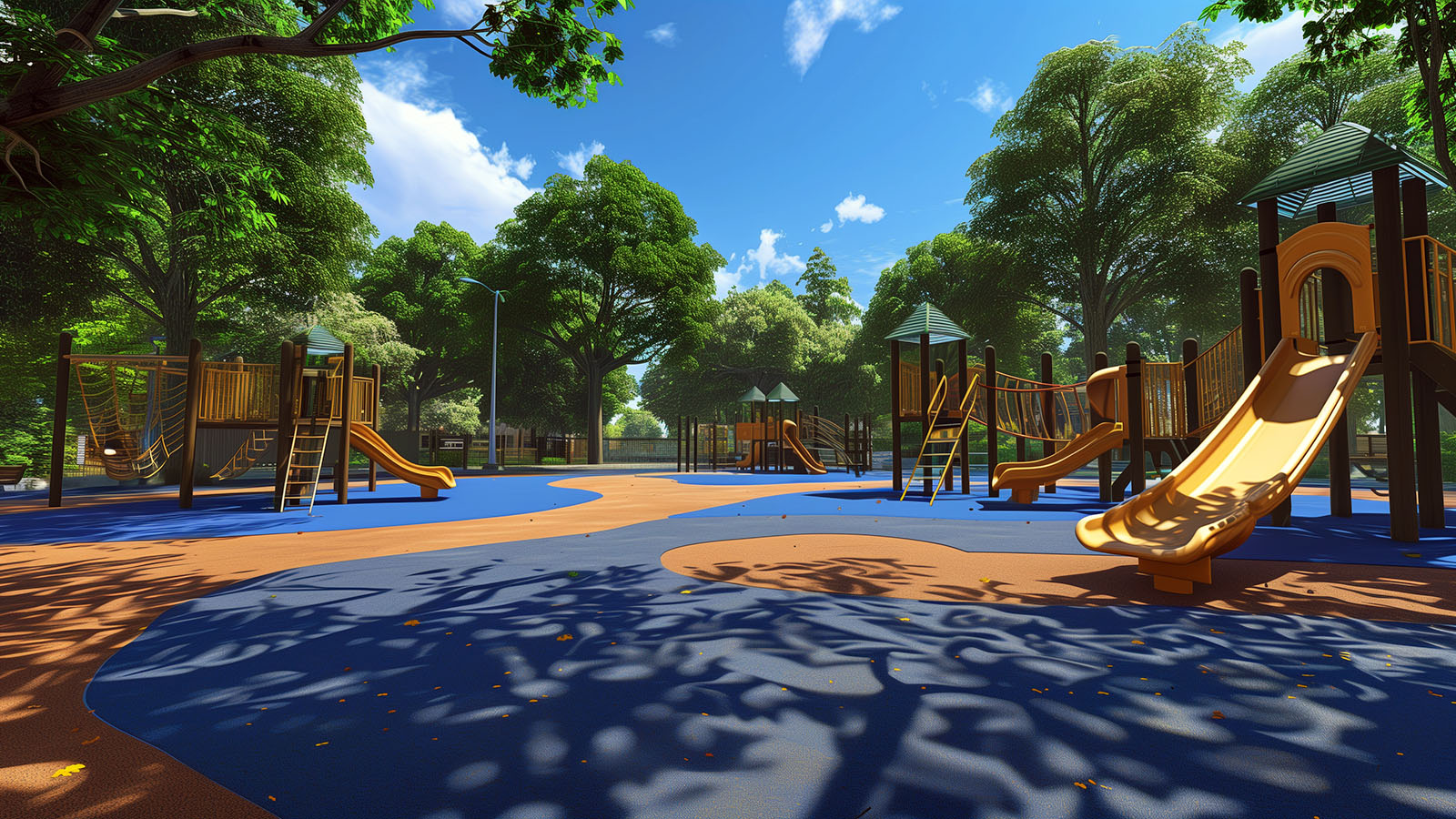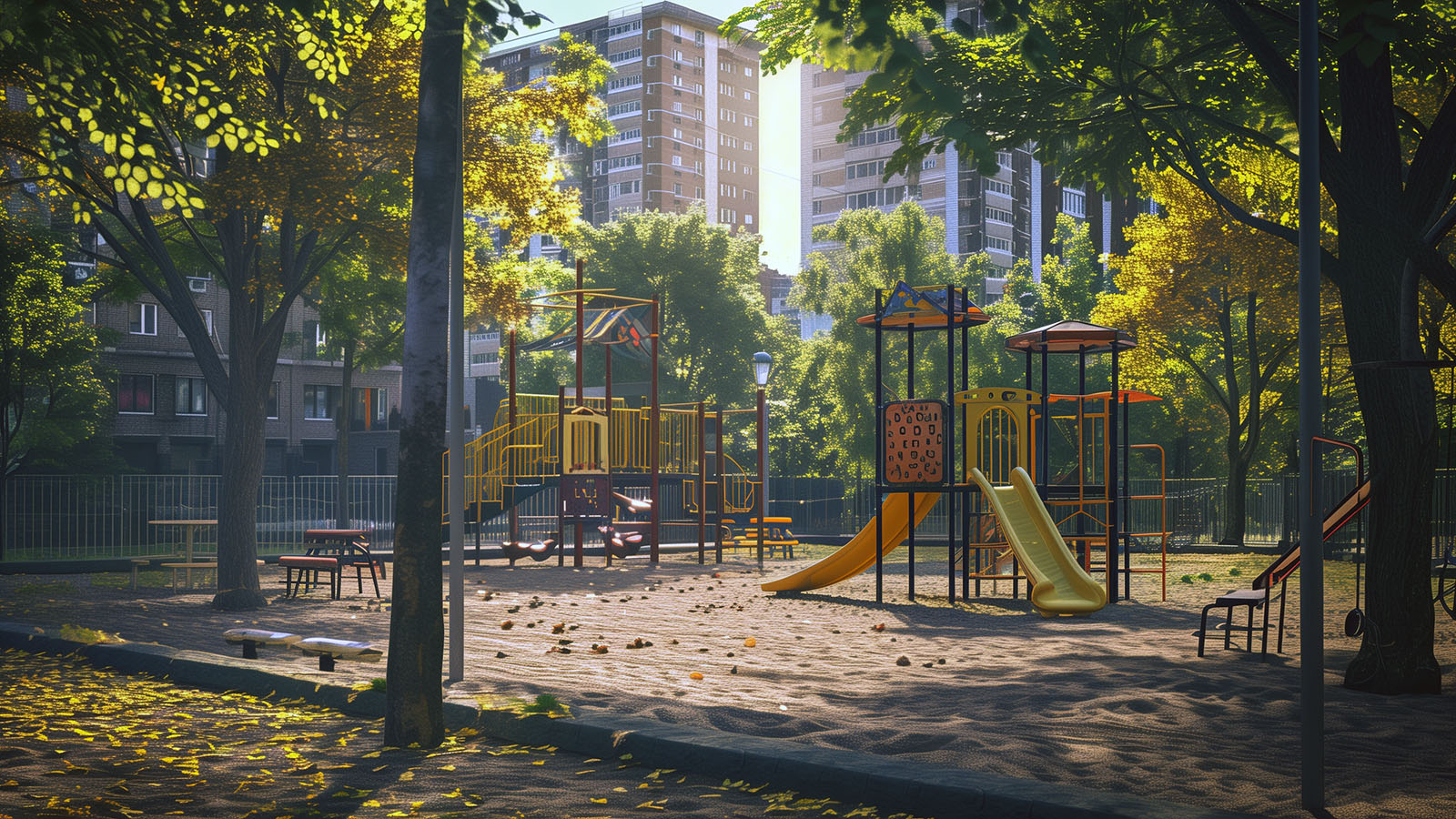2024-02-12
Top Considerations When Choosing Playground Flooring
The decision to select the appropriate playground surfacing is pivotal in designing an entire playground that is safe, functional, and appealing to children. This initial choice influences the overall safety, aesthetics, and usability of the play space, impacting how children interact with the playground equipment and each other. Safety surfacing, in particular, plays a critical role in minimizing the risk of injuries, ensuring that the inevitable falls and slips result in as little harm as possible. With many playground surfacing options available, from natural materials to synthetic solutions, choosing the right surface becomes a complex but crucial process. It’s not just about the visual appeal; it’s about creating an environment that fosters playful exploration while prioritizing the well-being of its young adventurers.
The need for durable and long-lasting surfacing becomes even more pronounced in commercial playgrounds. These play areas are subjected to extensive use, necessitating materials that can withstand daily activity’s wear and tear without compromising safety or comfort. Rubber playground surfaces, for example, have emerged as a popular choice among playground designers for their resilience and superior protective qualities. Unlike playground surfaces that may erode or compact over time, a unitary surface like poured-in-place rubber offers a consistent and reliable foundation that maintains its protective properties under heavy use. This makes it an ideal choice for commercial settings where the volume of play and the need for accessibility and safety are paramount.
Moreover, the selection of playground surfacing extends beyond the material’s functional attributes to its impact on the play space’s overall design and feel. The right surfacing can transform a plain play area into an inviting and vibrant community hub, encouraging children to engage in physical activity and social interaction. It’s not merely about providing a safe landing; it’s about enriching the playground experience. As such, the choice of surfacing material should be approached with a comprehensive understanding of its benefits and limitations, ensuring that the final decision aligns with the playground’s objectives and the community’s needs. By carefully considering the array of playground surface options, from rubber playgrounds to other unitary surfaces, decision-makers can create a play environment that is safe, engaging, and enduring – a place where children can joyfully explore and grow.


Understanding Different Types of Playground Surfaces
In creating safe, durable and engaging play areas, understanding the variety of available playground surfaces is crucial. Each type of surfacing material offers unique benefits and challenges, making it essential to consider your playground’s specific needs when selecting. From natural options like wood chips and pea gravel to engineered solutions such as rubber mulch and unitary surfaces, the right choice depends on safety requirements, maintenance capabilities, and aesthetic preferences.
Key Types of Surfaces
- Loose-Fill Materials: Discuss the common types such as engineered wood fiber (EWF), rubber mulch, wood chips, and pea gravel, highlighting their pros and cons.
- Unitary Playground Surfaces: Explain what unitary surfaces are, including poured-in-place rubber, rubber tiles, and synthetic turf, focusing on their benefits for playground safety and accessibility.
Each surfacing option has its place in playground design, catering to different needs and preferences. Materials like EWF and rubber mulch are favored for their shock-absorbing qualities, making them excellent choices for reducing playground injuries. Meanwhile, unitary surfaces such as rubber tiles and poured-in-place rubber offer a more consistent and stable surface, ideal for accessibility and reducing ongoing maintenance. Synthetic turf and loose-fill rubber options combine the benefits of natural aesthetics with the practicality of synthetic materials, offering versatile solutions for modern playgrounds. Understanding these options enables planners and community leaders to make informed decisions, balancing the demands of safety, functionality, and design to create inviting play spaces for children.


The Benefits of Poured-in-Place Rubber Playground Surfacing
Poured-in-place rubber surfacing stands out as a premier choice for playground flooring due to its unmatched safety, durability, and aesthetic flexibility. This type of unitary surfacing is meticulously engineered to provide a seamless, cushioned ground that significantly reduces the risks of injuries from falls, aligning with the paramount priority of playground safety. Beyond its protective qualities, poured-in-place rubber is celebrated for its ability to accommodate various designs and colors, allowing for creative and inclusive play spaces that spark joy and imagination in children of all ages and abilities.
Advantages of Poured-in-Place Rubber
- Safety and Injury Prevention: Poured-in-place rubber offers excellent shock absorption, reducing the severity of injuries from falls and making playgrounds safer for children.
- Durability and Low Maintenance: This surfacing option withstands extreme weather conditions and heavy use, requiring less frequent replacement and upkeep than loose-fill materials.
- Aesthetic and Functional Flexibility: Customizable in color and pattern, poured-in-place rubber can be tailored to fit the theme of any playground, enhancing its visual appeal and functionality.
- Environmental Friendliness: Often made from recycled rubber, poured-in-place surfacing is a sustainable choice that contributes to recycling materials like used tires.
The installation of poured-in-place rubber surfacing presents an opportunity to create play areas that are safer, more durable, and more engaging and accessible. Its smooth, continuous surface is ideal for children with mobility challenges, ensuring that playgrounds can be enjoyed by everyone, regardless of their physical capabilities. Additionally, the low ongoing maintenance associated with this surfacing material translates into cost savings over time, making it a smart investment for communities. By choosing poured-in-place rubber for playground flooring, decision-makers invest in a solution that meets the needs of today’s diverse and dynamic play environments, ensuring that playgrounds remain a source of joy, exploration, and growth for years to come.


Key Considerations for Selecting Playground Surfaces
Selecting the right playground surface is a decision that requires careful consideration of various factors to ensure the safety, accessibility, and enjoyment of all users. The choice of surfacing material can significantly impact the overall experience of the playground, affecting not only the risk of injuries but also the ease of mobility for children with or without mobility devices. Moreover, the compatibility of the surface with the playground equipment and the expected level of traffic are crucial aspects to consider. It’s important to assess the unique needs of your playground area, considering the local community’s requirements, the age range of the children who will be using the playground, and the specific types of activities the playground will accommodate.
Important Considerations
- Playground Equipment and Usage: The surfacing material should be chosen with the playground equipment in mind, ensuring it can absorb the impact from the highest fall zones.
- Installation and Cost: Consider both the initial installation cost and the long-term maintenance costs of the surfacing material, with poured-in-place rubber often offering a good balance.
- Compliance and Safety Standards: It’s essential to select a surfacing type that meets ADA compliance and safety standards to provide a safe and inclusive environment for all children.
In making the right choice for playground surfacing, decision-makers must also weigh the benefits of durability and aesthetic appeal against the requirements for ongoing maintenance and the potential need for future updates or repairs. The goal is to create a playground that looks inviting and stimulates imaginative play but also stands the test of time, maintaining its safety and functionality despite heavy use and exposure to the elements. Inclusive playground design, which accommodates children with mobility challenges, is another critical consideration, requiring surfaces like poured-in-place rubber that offer stability and ease of navigation. By considering these key factors, communities can develop playgrounds that serve as safe, enjoyable, and vibrant spaces for children to explore, learn, and grow.


Making the Right Choice for Your Playground
Making the right choice for your playground surface involves carefully analyzing your play area’s specific needs and conditions. It’s not just about picking a material that looks good or fits within a budget; it’s about creating a safe, engaging, and sustainable environment where children can play and explore. Among the variety of playground surfacing materials available, each has its strengths and is suited to different types of playgrounds. For instance, engineered wood fiber (EWF) offers a natural aesthetic and is often used when blending with the natural environment is desired. It’s a type of loose-fill surfacing that provides effective impact absorption, crucial for reducing fall injuries.
However, while materials like EWF are beneficial in many respects, they also come with considerations such as maintenance and accessibility. Loose-fill material can disperse and compact over time, requiring regular topping up and raking to maintain its protective properties. This maintenance is essential to ensure the playground remains safe for all children. Furthermore, loose-fill playground surfaces can present challenges for accessibility, as they might not provide the firm and stable surface needed for children with mobility devices. These factors are crucial in determining whether a loose-fill surfacing option is right for a playground, balancing the natural appeal and shock absorption qualities with the practicalities of upkeep and inclusivity.
Ultimately, selecting the right playground surfacing materials goes beyond just the surface. It involves considering the long-term impact on safety, maintenance, and accessibility. While loose-fill options like engineered wood fiber have their place in creating natural, cushioned play areas, decision-makers must also weigh these benefits against the need for frequent maintenance and the importance of accessibility. By carefully evaluating these factors, communities can choose a playground surface that meets the immediate needs of their play area and ensures a welcoming, safe, and enjoyable environment for all children for years to come.












